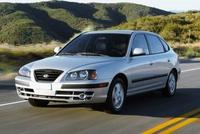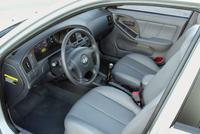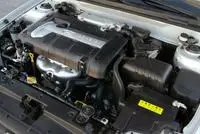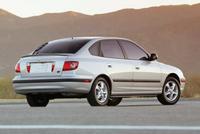New Car Review: 2004 Hyundai Elantra GT 5-Door
DRIVING DOWN THE ROAD
WITH CAREY RUSS
Hyundais have come a long way since the Korean manufacturer started selling cars in the U.S. in the mid-1980s. The days as a purveyor of merely basic cheap transportation are distant history, as Hyundai has expanded upscale in recent years with vehicles like the Santa Fe SUV and XG350 near-luxury sedan.
Yet it hasn't forgotten its roots. The inexpensive subcompact Accent continues, and the company's best-seller is the compact Elantra sedan. The Elantra came of age with the debut of the current, third-generation version in 2001. Although it still sold at a lower price point, it had all of the build quality and refinement of its Japanese competitors. A five-door hatchback model, the GT, was added in 2003. 2004 sees freshened styling inside and out, and modifications to the 2.0-liter twincam engine to reduce exhaust emissions. The GLS sedan gets SULEV emissions status when equipped with the optional four-speed automatic transmission; all other models are ULEV. The GT hatchback and sedan are sportier and more upscale, with a ``Euro-tuned'' suspension, four-wheel disc brakes, leather upholstery, an AM/FM/CD/MP3 CD audio system, and power steering, windows, mirrors, and door locks as standard equipment.
An Elantra GT 5-door has been my transportation for the past week, and it has been anything but basic. It's a solid and sporty car that can handle any small car need, be it economical commuting, city traffic, highway driving, or cargo hauling. Cargo hauling? Yes, with a flat-folding rear seat and the easy access of the rear hatch, the 5-Door is almost a baby wagon or SUV when it comes time to move stuff around. When it's time for driving, it is most definitely not a small truck, but an enjoyably sporty car. Versatility and a fun-to-drive character - a great combination.
APPEARANCE: Minor changes can make a noticeable improvement. The original third-generation Elantra front end had a ``pinched face'' look from the shape of the grille and headlights. All front sheetmetal and plastic is new, for a more contemporary international look. The raised hood, lower fenders, and matte-black triangular grille are fresh and distinctive. Dark material around the headlights gives a trendy smoked look without the drawbacks of smoked-plastic covers. Foglamps are found in the GT's lower front bumper fascia, and black inserts on the front bumper corners continue as side trim and across the rear bumper, adding protection as well as an upscale European look. The Elantra GT 5-door's are enhanced by its four-door hatchback body style, one popular in Europe if not (yet) in the U.S. (Four doors plus a rear hatch equals five doors, if you were wondering.) Restyled taillights with integral backup lights and a small spoiler at the edge of the deck lid. Alloy wheels are standard equipment on the GT.
COMFORT: Hey! That looks like leather on those seats. But this is a sub-$15,000 Hyundai, it must be a good synthetic. No, it's real leather, as is the covering on the shift knob and tilt-adjustable steering wheel. The main seat areas are perforated leather for better ventilation and comfort, and the GT's manually-adjustable sport seats are far more comfortable than expected in its class. The driver's seat cushion is adjustable for height and angle. A left foot rest and good positioning of the shift lever further contribute to comfort and a sporty driving experience. The redesigned interior styling is plain but honest, with no trendy faux-metal interior trim or slippery metal pedals. Instruments are easily read, and controls are well-placed. The standard Kenwood AM/FM/CD stereo also can play MP3 CDs. On the down side, the control buttons are tiny and poorly marked (as on every MP3 player I've ever seen) but that is outweighed by the positive: If you can invest a few minutes of computer time to make an MP3 CD, there is no need for a CD changer. Interior storage is good, with plenty of useful spaces. The rear seat is contoured for two, with space for a third passenger in the center. Space is average for the class, and the 60/40 split is not unusual. What is unusual is that the cushions flip up, allowing a flat load floor. With the good access from the low-liftover rear hatch and rear doors, the Elantra GT 5-Door can do cargo duty nearly as well as a small SUV. An integral but removable hard cover keeps cargo area contents out of view.
SAFETY: All Elantras made since 2001 have standard side as well as front air bags and front and rear crumple zones. Antilock brakes are available.
ROADABILITY: Hyundai touts the Elantra GT's fully-independent strut front, multi-link strut rear suspension as ``European-tuned,'' and with its relatively soft springing, and well-matched rate of damping, it does feel very similar to a small, sporty European car. That's ``sporty,'' not ``sports,'' and the difference is in intent. The Elantra GT is an everyday car for use in everyday world, not a racer-replica. So ride comfort gets priority over absolute handling, but it's still nimble and plenty of fun to drive. The GT's standard four-wheel disc brakes help it to stop securely.
PERFORMANCE: All Elantra models use Hyundai's 2.0-liter dual overhead cam four-cylinder ``Beta'' engine, which now has continuously-variable valve timing to add power at the top and torque at the bottom of its power range, and to decrease emissions. In SULEV spec for the automatic GLS it makes 132 horsepower. The ULEV version in the GT makes 138 horsepower at 6,000 rpm and 136 lb-ft of torque at 4500 rpm. This puts it in the ballpark with other small, sporty sedans, and provides good fuel economy - nearly 30 mpg average - as well. It work best in the midrange, and can easily and pleasantly be kept there by use of the standard five-speed gearbox. Excellent, precise shift linkage adds to driving pleasure.
CONCLUSIONS: Hyundai takes on the world's best compact sedans and hatchbacks with its Elantra.
SPECIFICATIONS
2004 Hyundai Elantra GT 5-door
Base Price $ 14,849
Price As Tested $ 14,887
Engine Type Dual overhead cam inline 4-cylinder with
continuously-variable valve timing
Engine Size 2.0 liters /
120 cu. in.
Horsepower 138 @ 6,000 rpm
Torque (lb-ft)
136 @ 4,500 rpm
Transmission 5-speed manual
Wheelbase /
Length 102.7 in. / 177.9 in.
Curb Weight 2,635 lbs.
Pounds Per Horsepower 19.1
Fuel Capacity 14.5 gal.
Fuel
Requirement 87 octane unleaded regular gasoline
Tires
P195/60 HR15 Michelin MXV4
Brakes, front/rear vented disc /
solid disc
Suspension, front/rear independent strut /
independent multi-link strut
Drivetrain front engine,
front-wheel drive
PERFORMANCE EPA Fuel Economy - miles per gallon city /
highway / observed 27 / 34 / 28
0 to 60 mph 8.6 sec
OPTIONS AND CHARGES
Trunk cargo net $ 38
Hyundai Elantra Intro Press Release
December 30, 2003 -- Fountain Valley, CA -- The Elantra is Hyundai's best selling model in the U.S. and for 2004, the Elantra receives sheet metal styling revisions and interior enhancements. The 2004 Hyundai Elantra is available in three trim levels -- Elantra GLS, Elantra GT 4-door and Elantra GT 5-door.
What's New
The styling is new for 2004, giving the Elantra a more refined, more European look. The design features a new hood, front fenders, bumper, headlamp assembly and a revised grille design. Complementing the new headlamp design is a revised V-shaped grille featuring bold, horizontal bars. The grille is now integrated with the bumper cover and does not lift up with the hood as in the past. The revised front bumper features wider slats and there is a smaller, more precise opening for the fog lamps.
At the rear of the new 2004 Elantra is a revised tail light design, and the rear decklid now features a sharper accent line and the key cylinder has been relocated from the center to the right side. The handsome body color rear lip spoiler on the Elantra GT 4-door has been redesigned and is lower than the previous version. On the Elantra GT 5-door, the rear lip spoiler has been redesigned and is now body colored for a more attractive appearance. There are five new exterior paint colors available for the 2004 model year.
Interior Upgrades
For 2004, the Hyundai Elantra receives many interior upgrades including: a new instrument cluster with separate faces for the speedometer (on the right) and tachometer (on the left), new vents and vent controls, new seat fabrics and a new center console stack. In addition, the HVAC controls have been revised; there are also new moonroof controls and power door lock controls.
Other attention-to-detail changes include new seat fabrics and the addition of a second 12-volt power source in addition to the lighter. Even the ash tray got some attention; a push-type ashtray replaces the older pullout style and it now has a removable liner for easy cleaning and service. The child seat anchors have been recessed and covered with plastic snap-up covers with easy-to-read icons embossed into the covers.
There is now a small, felt-lined storage pocket located near the driver's side air vent. The driver's door switch panel now controls the power window operation, side mirror controls and central locking function.
The overhead room lamp has been moved to the overhead position in the center of the cabin. Previously it was located in the overhead console just above the rear view mirror. There are now two, 12-volt power sources available; the lighter and an auxiliary 12-volt outlet. Previously the only 12-volt power source available was the lighter. The hazard switch panel is now located in a freestanding position in the center of the center stack which makes it easier to find quickly.
Controls for the available moonroof have been changed. The operation is now more intuitive and uses easy-to-read icons for easy operation.
For 2004, the Elantra GT models are now equipped with a Kenwood AM/FM/CD/MP3 audio system. The system features the Color Shock variable color display, built-in 50 watt x 4 amplifier and System Q Sound Control with preset EQ curves. The system also incorporates a removable faceplate with carrying case and a grip-type remote control.
Other changes for 2004 include a revised dimmer switch panel and updated multi-stage door lock controls.
Remote keyless entry with alarm is now standard on all Elantra models and includes a new feature for 2004 for that allows unlocking the trunk without having to disarm the security system. The system will now temporarily by-pass security (with the key) to provide quick access to the trunk and rear cargo area.
A new feature designed to make things easier for do-it-yourself maintenance is the use of two thumbscrews to attach the panel that provides access to the rear combination lamps. In the previous model Elantra the panel was held in place by pressure lift tabs.
Engine Upgrades
All 2004 Elantra models are powered by Hyundai's proven Delta 2.0-liter, four-cylinder DOHC engine. Continuously Variable Valve Timing (CVVT) has been added for even more precise control of engine emissions. The CVVT unit is mounted on the exhaust camshaft but controls the intake valve timing by advancing and retarding the intake cam in relation to the exhaust cam.
The Powertrain Control Module (PCM) controls the amount of timing advance up to 40 degrees of crank angle (20 degrees of camshaft angle). The CVVT system delivers improved performance at high RPM and increased torque at low RPM through increased volumetric and thermodynamic efficiencies. In addition, fuel economy is increased due to better cylinder charge achieved through increased valve overlap.
By optimizing valve overlap, the NOx emissions are reduced due to the EGR effect.
When tuned to SULEV specifications in the GLS model with automatic transmission, the 2.0-liter engine is rated at 132 horsepower at 6,000 RPM and delivers 133 lb-ft of torque at 4,500 RPM. In ULEV trim the engine is rated at 138 horsepower at 6,000 RPM and 136 lb-ft of torque at 4,500 RPM.
Elantra GLS
The Elantra GLS is the smart choice for family sedan buyers. The handsome new styling of this front-drive, four-door sedan is backed with an impressive list of standard equipment which includes driver and passenger front and side impact airbags, fully independent suspension, air conditioning, power windows, door locks and mirrors, AM/FM stereo with cassette, 15-inch wheels with full wheel covers, center console with armrest, 60/40 split folding rear seat, body colored mirrors, door handles and bodyside moldings, tilt steering column and rear window defroster.
Elantra GT
The impressive standard equipment list for the GT models (4-door and 5-door) includes all of the class-leading standard equipment found on the Elantra GLS sedan and adds: four-wheel disc brakes, 15-inch alloy wheels fitted with Michelin P195/60R-15 tires, Euro-tuned suspension, air conditioning, leather seating, power steering, power windows, mirrors and door locks, AM/FM/CD stereo system and fog lamps, white-faced instrument cluster with purple instrument lighting and a rear deck spoiler.
"All the Elantra models with their new styling and extensive list of standard equipment continue to enhance the Hyundai brand in the U.S. " said Hyundai Motor America's Acting President and CEO Robert Cosmai. "Elantra offers buyers a rare combination of features - value and performance with a 'fun-to-drive' factor."
The Elantra GT 5-door is a front-drive, five-door hatchback design that offers consumers the versatility of a wagon combined with the ride and handling of a European sedan. The Elantra GT 4-door takes performance and handling up a notch for the Elantra sedan. In addition to their stylish good looks, the Elantra GT models are loaded with value.
This third generation Elantra platform, introduced in 2001, is slightly larger than the previous version and offers more headroom and more rear seat leg and hip room. The wheelbase at 102.7-inches is 2.3-inches longer than the wheelbase of the previous Elantra.
For this generation the Hyundai engineers added refinement to an already impressive package. The Elantra is smooth and quiet thanks to a front subframe, hydraulic engine mounts, an eight-counterweight crankshaft, a ribbed engine block, cast-aluminum oil sump and integrated intake resonator.
In addition to being practical and roomy, the Elantra is also comfortable. The luxurious seats (cloth in GLS, standard perforated leather-seating surfaces in GT) are larger and more comfortable than the seats in the previous version of the Elantra.
The six-way adjustable driver's seat has a dual-height adjustment and both front seats offer lumbar support to enhance comfort and reduce fatigue on long trips. Front headrests and front seat belt anchors are adjustable and all seats feature advanced design cushions that adapt to the size and shape of the passenger.
The controls are easy to access and easy to operate. The precise acting rotary knobs make operating the standard air conditioning system a breeze. The option list is very short: available options for the Elantra GLS include anti-lock brakes with electronic traction control and a power tilt/slide moonroof.
The Elantra features fully independent suspension front and rear. In front the Elantra is fitted with MacPherson struts with gas-filled shock absorbers, offset coil springs and an anti-roll bar. In the GT models, the gas-filled shock absorbers are tuned to European specifications and they are matched to a 24mm front anti-roll bar. The rear suspension is a fully independent multi-link design with offset coil springs, gas-filled shock absorbers and an anti-roll bar. GT models are upgraded to Euro-spec gas-filled shock absorbers and 15mm anti-roll bar.
All Elantras are equipped with 15-inch wheels and tires. The GLS has P195/60R-15 Michelin tires mounted on 15 x 5.5-inch steel wheels with full wheel covers. The GTs are fitted with P195/60R-15 Michelin tires on 15 x 6-inch alloy wheels. These wheel/tire packages, when combined with the fully independent suspension, provide the Elantra with smooth, precise handling. GT models with Euro-tuned suspension and larger anti-roll bars bring a taut, sporty feel to the Elantra.
Elantra stopping power is also precise. The GLS features power front wheel disc brakes matched to rear drum brakes. Four-wheel disc brakes are standard on the GT models. They use 10.1-inch ventilated discs up front and 10.2-inch solid discs at the rear. Hyundai's four-channel anti-lock braking system with traction control is an available option.
Side Airbags Standard
The Hyundai Elantra has a long history of providing the driver and passengers both active and passive safety features. In addition to the driver and passenger front air bags, side impact airbags are standard as well. They were added as standard equipment with the 2001 model year.
Additional safety features include a seat belt system containing pretensioners with force limiters. The pretensioners automatically limit slack in the front seat belts at the onset of a collision, preventing the occupants from moving too far forward when impact occurs. The Elantra's anti-submarining front seat design works with the seat belt system to help keep occupant's bodies in the seats, reducing the chances of slipping out from under the belts.
Other safety features include child safety door locks, a child seat anchor system and automatic locking retractors (ALR) and energy absorbing steering column. Energy absorbing crumple zones in the front and rear help protect the passenger compartment.
America's Best Warranty
Underscoring the Elantra's position as a value leader in the compact sedan segment is its industry-leading assurance package, the Hyundai Advantage, America's Best Warranty. With this outstanding protecting package, Hyundai demonstrates its confidence in the quality of its products by providing warranty coverage exceeding that found on vehicles costing twice or even three times as much.
All Elantra models, like all other Hyundai vehicles sold in the U.S., are backed by limited bumper-to-bumper coverage for five-year or 60,000 miles. Hyundai also provides original Elantra owners and their immediate family with limited powertrain coverage for 10 years or 100,000 miles.
Even if the car is sold, Hyundai still backs the Elantra's powertrain for five years or 60,000 miles. Elantra buyers also receive 24-hour roadside assistance at no extra charge for five full years (no mileage limit). The warranty also includes emergency towing, lockout service and limited coverage for trip-interruption expenses.
In addition, Hyundai backs the Elantra with corrosion coverage for five years or 100,000 miles.
Hyundai Motor America, headquartered in Fountain Valley, Calif., is a subsidiary of Hyundai Motor Company of Korea. Hyundai cars and sport utility vehicles are distributed in the U. S. by Hyundai Motor America and are sold and serviced through more than 600 dealerships nationwide.






